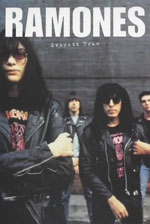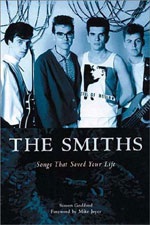Heavy words are so lightly thrown... | |

| There's more than one way to string a Strat, and there are several ways to tell the story of a band. The most obvious is a straight, chronological biography, and that's what forms the spine of Everett True's Hey Ho Let's Go: The Story Of The Ramones (Omnibus £17.95). He introduces the original band members, describes the nascent NYC punk scene of the mid-1970s in all its glory and vileness, then takes us on an expertly navigated trawl through the uppers and downers of a seminal outfit: dodgy politics, dodgier haircuts, drugs, death, and all things pinheaded. There's a thorough discography, anecdotes, photos - essentially all the accoutrements of a definitive biog. But, this being the incorrigible Mr True, things aren't that straightforward. He's the master of a kind of zelig/gonzo hybrid, putting himself at the centre of the narrative, then stepping slightly to one side. The reader's view of the main action isn't obscured, but you can hear the keys jangling in Everett's pockets, even if you're looking at Dee Dee or Joey. So the introduction is a series of snapshots of the author's various interactions with the Ramones, from the moment he bought Too Tough To Die in 1984, via the time Joey passed ET's prostrate form at Lollapalooza in 1996, and back to the embryonic hack's gabba initiation in 1976, via his brother's copy of the first album. And, unsurprisingly, by the end of the book he manages to get in a droll sneer at Courtney Love's expense. Of course, True himself wasn't at the heart of the Ramone universe (at least not in the same way that he was when grunge broke) and the parts of the book that sparkle are the interviews with people who really were there. The key players push the narrative along, but it's the diehard fans that shine a light on why The Ramones were significant. For example, the dwarfish, dysfunctional George Tabb describes how he gained a sense of community by always wearing a Ramones t-shirt, forming a bond with fellow fans wherever he went. "They helped a lot of kids identify with something and kept us alive," he says, simply. This tactic, of defining the music through the reactions of the faithful, is only truly successful when applied to a band whose appeal is cultish and selective. Unsurprisingly, The Smiths are a prime example of this. The 1995 book All Men Have Secrets was an alphabetical compilation of fans' jottings about almost every Morrissey/Marr composition. Not reviews, note - it was a mix of anecdotes, autobiographies, jokes, confessions, self-therapy, even obituaries for lamented friends, each sparked by a particular song. Like lyrics scrawled over an exercise book, they offer a profound, if elliptical, view on why some bands are important, whether you like it or not. Willy Russell's The Wrong Boy is also important; like The Catcher In The Rye being read aloud to a backing of "Oscillate Wildly", we see the decline and redemption of a moderately fucked-up but essentially decent teenager. The novelty is that the whole narrative is told through young Raymond's (presumably unsent) letters to Morrissey. Like an indie-pop variant of transactional analysis, the key to understanding either party is in the relationship between them, in this instance the one-way dynamic between the fan and the idol. |

| If this is the most effective way to get under the pasty skin of The Smiths, it seems perverse of Simon Goddard to follow the quasi-academic, analytical method, as he does in The Smiths: Songs That Saved Your Life (Reynolds & Hearn, £14.99). Every author who attempts to encapsulate a band in this way has a massive presence looking over his shoulder, in the form of Ian Macdonald, whose Revolution In The Head, covering the music of The Beatles, combines a musicologist's deconstruction technique with social and historical context. Goddard is keen to stress the link between the two books - he mentions (twice) that his book is inspired by Macdonald's, with the latter's blessing. But this is where Songs That Saved Your Life falls down. Even if The Beatles had never done or said anything noteworthy beyond the grooves of their records, Macdonald would have had plenty to say about the music itself. Love or loathe them, they redefined the notion of how a pop record could sound, bringing in classical, jazz, and Indian musicians, and making crucial innovations in the use of tape manipulation and synthesisers. While The Smiths came up with plenty of good tunes, and Johnny Marr is an inventive guitarist and studio technician, that's not what makes the band special. The key attraction (or, for the doubters, the main problem) has always been the personality of Morrissey, and his lush, moving, infuriating, indulgent, savage, daft lyrics. Presumably for copyright reasons, Goddard quotes only sparingly from Steven Patrick's gemstones, and is left to describe, time after time, Marr's multi-tracked fingerwork, with occasional nods to Rourke's and Joyce's dexterity. Not until their third (and penultimate) studio album did The Smiths make serious attempts to flesh out their sound, and then it was usually a case of Marr coming up with a new noise on his Emulator. And surely everybody on the planet knew already that the strings on "There Is A Light That Never Goes Out" aren't real? Another problem with Goddard's approach is that it requires absolute precision. In most pop journalism, the occasional slip-up can be passed off as an appropriate avoidance of sterile perfection, like a broken string, or getting struck in the mouth by a pasty. But when you're digging this deep, and attempting to tell the definitive story, there's no room for even a minor goof. Misspelling John Gielgud's name (he's sampled on "Rubber Ring") is tolerable, as he's only really of peripheral interest; doing the same for Andrew Ridgeley is amusing, but sloppy; mangling the names of Morrissey's treasured girl group favourites, The Marvelettes and The Velvelettes, is out of order. Minor matters, perhaps, and ultimately the responsibility of the proofreader, but Goddard then goes on to slam the Very Best Of The Smiths compilation for "unforgivable typo errors". He proceeds to misuse that critical favourite, the word "antithesis", and also blithely dismisses as "urban myth" the idea that the "melting Walkman" line in "Bigmouth Strikes Again" was inspired by a Kenny Everett sketch, because cuddly Ken was "an aggressive supporter of Thatcher". As if indeterminate sexuality and confused political ideas ever stopped, say, Kenneth Williams or Oscar Wilde being suitable role models. Or, indeed, Morrissey himself... Perhaps the moral is that Macdonald's mighty tome has, like The Beatles, done as much harm as good. The band's influence in the 70s led to monstrosities like the Electric Light Orchestra; Revolution In The Head leads to overenthusiastic writers trying to apply its techniques to inappropriate bands. (An honourable exception is Nicholas Pegg's The Complete David Bowie, also published by Reynolds & Hearn, a second edition of which has just come out.) True's democratic reportage from fans and friends is, in a way, the equivalent of punk rock within the medium of the pop biography. It probably doesn't signal Year Zero for the school of intensive analysis, but it might alert a few writers and publishers to the fact that it's not very rock 'n' roll. © 2002 Tim Footman |